Standing up for Canadian flag’s 50th birthday .. and Sarah Palin, Emma Holten, migrants to Canada and USA
Jan 31st, 2015 | By Citizen X | Category: In Brief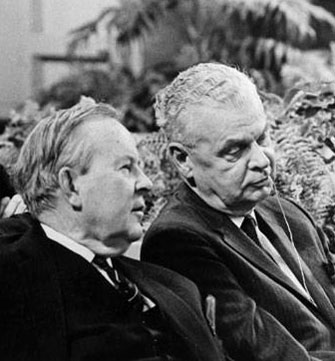
Lester Pearson (l) and John Diefenbaker (r) share a moment in 1969, when both were no longer in office.
This past January 13, on the Waterloo Region Record site, Â Lee-Anne Goodman wrote : “With the 50th birthday of Canada’s beloved Maple Leaf flag just a month away, some are wondering why there’s been so little fanfare from the federal government.”
One possible half-answer is that the Conservative Party of the mid 1960s, led by the Renegade in Power John Diefenbaker, fought against the introduction of Canada’s now beloved independent Maple Leaf flag, which was championed by Lester Pearson’s Liberals. The Conservative Party of 2015 – for whom Mr. Diefenbaker remains some kind of historic great leader – is understandably reluctant to remember all this in great detail.
There are no doubt bigger and broader answers as well. Lee-Anne Goodman also notes, eg, that when pressed about celebrating the 50th birthday of the flag, Heritage Minister Shelly Glover has said “there were not a lot of funds set aside for the 50th anniversary of the flag” because her officials “were planning out the 150th birthday of Canada” – on July 1, 2017 – and “they were going to recognize milestones within it.”
Some may feel this raises another and certainly more vast awkwardness. What kind of country celebrates its 150th birthday in 2017, but only the 50th birthday of its beloved flag in 2015 (on Sunday, February 15, 2015, to be exact)? And/or, that is to say, just what kind of a country is it that takes 98 years to come up with a flag ????
1. Canada “not a nation” in 1860s
We may puzzle over questions of this sort today. But our predecessors in the Canada of the later 19th century knew the answer well enough.”Canada,” George Brown of the Globe in Toronto thundered to anyone who might be reading his newspaper in the fall of 1874, “is not a nation.”
Just what Brown of the Globe was driving at in 1874 was explained by the excellent Canadian political historian P.B. Waite just under 100 years later. The Canadian confederation that began in 1867 “did not yet have enough strength to stand alone. If she did, she would at once be captured by the United States. To propose Canadian independence from Great Britain was equivalent to treason.” Â So … the Canada of 1867 was not yet a nation or an independent country in its own right. It was just the first self-governing dominion of the global British empire – on which the sun never dared to set …
Yet things have changed since 1867, of course, in many ways. There is, eg, no longer a British empire. At best it has been succeeded by the Commonwealth of Nations, which is a quite different international organization. Canada has very gradually become at least a somewhat complicated independent country in its own right. It has haphazardly followed a path alluded to by the Osgoode Hall constitutional law professor Brian Slattery in the middle of the 1990s, when he wrote about “the long process of decolonization that Canada has undergone since 1867.”
The birth of  Canada’s now beloved independent Maple Leaf flag in the middle of the 1960s was part of this decolonization process. We should no doubt also confess that the maple leaf flag’s popularity as a symbol today is not always the same as the popularity of what’s being symbolized, eg, on some reserves of the Aboriginal Peoples of Canada and in perhaps many parts of Quebec – and maybe even … well fill in your own blanks. But it seems true enough that among some diverse majority, including many anglophones and some francophones, some aboriginal peoples of and quite a few people born outside Canada, the maple leaf flag has somehow established itself over the past half century. And that must mean something.

Consensual nude photo apostle, Emma Holten from Denmark. During a long conversation with CBC News in Canada recently, she did not question the Canadian maple leaf flag that was officially born in 1965!
As the former Toronto City Councillor Tony O’Donohue has recently urged, on a new Canadian republican website, the long process of decolonization of which the official birth of the maple leaf flag on February 15, 1965 was a part is still not quite complete, even in 2015. The most crucial step that remains is “having our own distinct Canadian head of State, chosen by Canadians,” instead of the British monarch, who in theory (and in the Harper Conservatives’ particular dreams apparently) remains Canada’s ceremonial head of state, shared with the United Kingdom and 14 other so-called “Commonwealth realms.” (The majority of the Commonwealth’s 53 members today are republics, with their own independent heads of state – a status pioneered by India in 1950.)
Meanwhile, just what happened in the middle of the 1960s to give the old first self-governing dominion of the British empire its own flag, and lock in its own manifest destiny as an (again complicated, still somewhat fragile, and so forth) independent country in its own right, is probably worth pondering in a little more depth. It might help Canadian republicans understand the complex fate that lies before them in the 21st century a little better.
2. Â Alistair B. Fraser’s Canadian flag history in 1960s
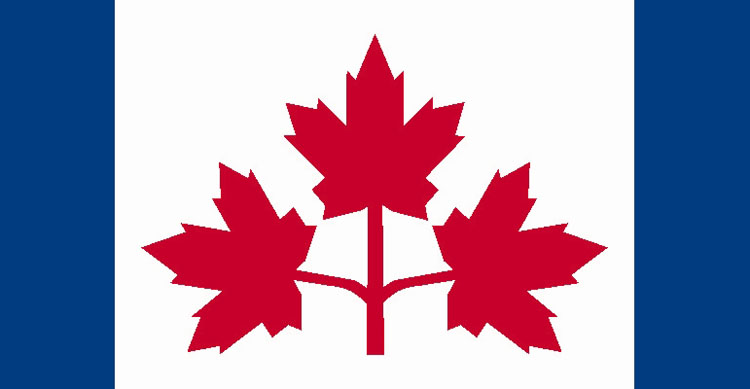
So-called Pearson Pennant – flag design initially supported by Prime Minister Lester Pearson, but then abandoned for the red and white single maple leaf with red bars to win a key committee vote.
Those with access to the world wide web also have access to what is probably the single best history of the road to the maple leaf flag of February 15, 1965 – Chapter V of Alistair B. Fraser’s Flags of Canada, which was posted on the Web at the end of January 1998 and happily remains there today.
Mr. Fraser was born and raised in Rossland, BC (also home to a very young John Turner). He graduated from UBC with a BA in Math and Physics in 1962. He then “started my professional career with the Canadian Government as a weather forecaster in Vancouver before returning to school to gain a PhD in Meteorology from the Imperial College of the University of London.”
He graduated from Imperial College in 1968, and then taught at the University of Washington until 1978, when he became a Professor of Meteorology at Pennsylvania State University. He retired from Penn State in 2001. Alistair Fraser and his wife Dorothy now live “on the shore of  Kootenay Lake, British Columbia, Canada.”
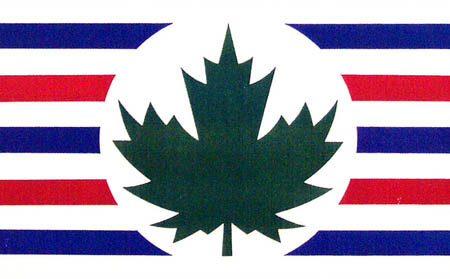
One of more than 2000 maple leaf flag designs submitted to a special parliamentary committee in Ottawa by legendary ordinary Canadians in 1964 that did not make the final cut.
Along with his technical publications in meteorology (eg, The Atmosphere – a textbook co-authored with three others, various contributions to the American Meteorological Society’s Glossary of Meteorology, and articles in such journals as Applied Optics and Agricultural and Forest Meteorology), Alistair Fraser has published articles and books on broader themes. The Rainbow Bridge : Rainbows in Art, Myth, and Science (2001), co-authored with Raymond L.Lee Jr.,is one case in point. Â “Who Dares Call BC ‘The Northwest’? …And who decided I live in ‘The Kootenay Rockies’?”, published on The Tyee website in 2005, is another.
I don’t know myself just when and how the professor of meteorology became interested in Canadian flags. But in 1989 he was “the instigator, consultant, and supplier of extensive material for” an “exhibit of the history of Canada’s flags” at the Canadian Museum of Civilization (now known as the Canadian Museum of History) in Ottawa, to celebrate the 25th anniversary of Canada’s beloved Maple Leaf flag on February 15, 1990.
The best way to learn about Chapter V of Alistair B. Fraser’s Flags of Canada , nicely titled “A CANADIAN FLAG FOR CANADA,” is just to read it yourself. But it has two notable general virtues that I want to quickly point out before moving along.
To start with, Fraser’s account stresses that what came to an ultimate fruition in the Canadian House of Commons during the last half of 1964 was just the culmination of a story going all the way back to the late 19th century (or at least the 1920s, from some more rigorous points of view). In many different ways (including opinion polls), many people from many parts of the country contributed to what officially became the beloved Maple Leaf flag on February 15, 1965. It was not just the work of a few politicians and their advisors.
Mr. Fraser’s account also shows how the long struggle for an independent Canadian flag was also, to the very end, a fight between two sides of the community from coast to coast to coast. One side Fraser calls “Canadian imperialists” (like Conservative leader John Diefenbaker – who believed  the old British red ensign with a Union Jack in the corner and a Canadian crest was as much of a flag as Canada needed).The other side he calls “Canadian nationalists” (like Liberal leader and former External Affairs minister Lester Pearson, who had become convinced Canada really needed a flag of its own at last by his experience helping to resolve the Suez Crisis of 1956, for which he received the Nobel Peace Prize in 1957). We don’t seem to use these terms today as they were used in the past. But Tony O’Donohue might say that there is still a struggle going on between these same two sides with different names. Nowadays the Canadian imperialists call themselves Canadian monarchists. And Canadian nationalists have become Canadian republicans. At some point some Canadian prime minister like Lester Pearson – pushed by the rising demands of the Canadian people –  will quietly arrange the retirement of the British monarchy. And the long process of decolonization will end.
3. Other flag history sources and stories
* Awesome Canadian Flag Designs That Got Cut (PHOTOS) … The Huffington Post Canada / Â By Michael Bolen / Posted: 10/16/2013 4:13 pm EDT Updated: 11/03/2014 3:59 pm EST
* Revisiting Canada’s great flag debate
* CBC Newsmagazine (TV), Broadcast Date: Dec. 28, 1958, Guest: J.A. Picard, Reporter: Norman DePoe. The Native Sons of Canada launch a campaign for a distinctive national flag. It resurrects the debate among Canadians over what they’d like to see on their flag. Over the years, designers have submitted ideas, from elaborate silk and gold creations to cardboard cut-outs … Native Sons of Canada’s J. Picard … says the best way to get recognition for a flag design is to fly it. He agrees with Liberal Party leader Lester B. Pearson who says if enough people fly the flag, the government will sanction it.
* Great Canadian Flag Debate … From Wikipedia, the free encyclopedia [Really quite good I thought … well, more or less.]
* The Great Flag Debate … Canadians respond with passion and dissension as the country seeks a new national symbol … “”Quebec does not give a tinkers dam about the new flag,” Liberal politician Pierre Trudeau said. “Its a matter of complete indifference.”” … Â When Diefenbaker died in 1979, his coffin was draped with both the Red Ensign and the new flag … Â However, Canada’s new flag was generally well received by the public. The large generation of Canadians born after the Second World War took to the country’s new symbol. The government used Canada’s 100th anniversary celebrations in 1967 to promote the new flag throughout the country.
* Canada’s official flag from 1867 had been Britain’s Union Flag, although the Red Ensign with the Canadian badge was regularly flown for qualified purposes. In 1925 Prime Minister Mackenzie King appointed an armed services committee to investigate possible designs, but it did not report. In 1946 a committee of both Senate and Commons presented a design with the Red Ensign charged with a golden maple leaf but it was not adopted. The issue was raised again by Lester Pearson, as leader of the Opposition in 1960 and as prime minister in 1963 …
* “Does Canadian flag have a father, or a birthplace?”
* “Debate heats up over ‘birthplace of Canadian flag’ claim”
* “It is hard to believe, after all evidence to the contrary, that Brockville city council has authorized its staff to use the “Birthplace of the Canadian flag” tag on official city correspondence”
* “Monday, Nov. 10, 2014 — 10:44:38 am … Brockville Council Invite Tonight … Good Morning everyone, I wanted to let all interested parties know, 50 Years of Our Flag Committee have been asked to attend Brockville City Council this evening to defend our claims that, John Ross Matheson is the true ‘Father of Our Flag’ and Brockville, Ontario has the right to declare itself ‘Birthplace of the Canadian Flag’.”
4. Sarah Palin – “When a far-right fraud wears out her welcome” ???? … or is it just that she’s losing her looks!
My treasured emails from The Rachel Maddow Show reported on the once-loverly Sarah Palin this past Thursday, under the headline “When a far-right fraud wears out her welcome.”
Then when I saw the latest clip of the X Governor of Alaska in her distress (on Rachel’s MSNBC TV show, I think), I thought part of her problem is that, just like the rest of us who are 50 years and older, she is starting to lose her looks … Remember Sister Sharon in Elmer Gantry? So much depended on her looks too (Jean Simmons in the movie, I think) …
5. Emma Holten is right about consent … and also pretty cute …
If you don’t know who Emma Holten from Denmark is, check out, eg : “Emma Holten responds to nude photo leak with consensual images …’I don’t see a problem with being naked on the internet, that’s not where the problem lies,’ Holten explained. ‘The problem lies with the fact that my consent has been violated.’” … CBC News Posted: Jan 29, 2015 11:58 AM ET Last Updated: Jan 29, 2015 1:03 PM ET.
I was especially convinced by the passionate conclusion of her video on the Guardian site, “Someone stole naked pictures of me. This is what I did about it.” I totally agree with what she says right at the end, when she focuses on the moral question of “consent,” and compellingly argues that “pictures shared with and without this consent are completely different things.”
Still, would Emma Holten herself be getting quite so much attention if she weren’t so cute? Will she no doubt have some kind of larger career now that she has managed to get this much attention for her 15 “consensual images” minutes (or is it just seconds?) of fame?
6. Why are Canada and the United States attracting somewhat different kinds of migrants from the global village ?
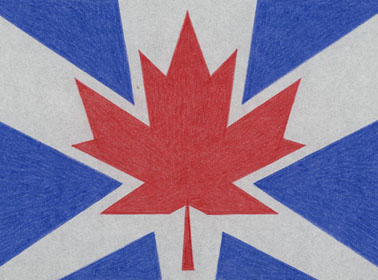
Yet another that did not make the cut in 1964. But it is still with us in spirit, just like all the other more than 3,000 design submissions from ordinary Canadians.
Here is an intriguing recent finding from the Gallup organization : “Based on their scores, Canada is more attractive to more educated potential migrants than the United States … Â This may reflect Canada’s appeal to these groups with its programs for new migrants that focus on language and job training. But this is consistent with earlier Gallup research that shows the US appeals more to the youngest and least educated potential migrants, while those who choose Canada are, on average, slightly older and more educated. These differences may partly reflect the emphasis” in “each country’s immigration policy.”
Anyway, ave atque vale (“hail and farewell”), via con dios, till we meet again, etc, etc, etc, etc. And don’t forget : VOTE IN THE CANADIAN FEDERAL ELECTION OF 2015, PROBABLY ON OCTOBER 19.
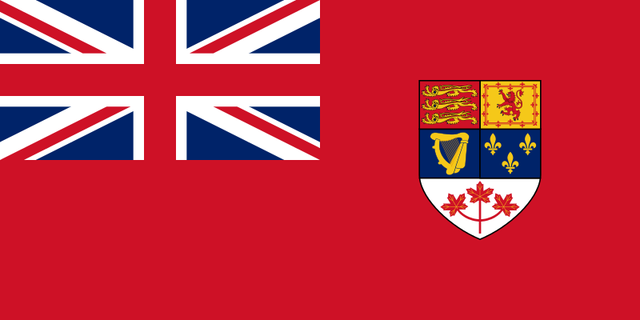
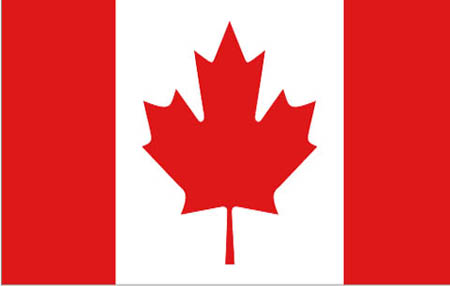
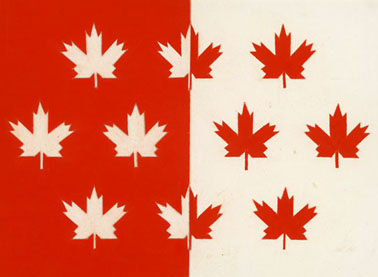

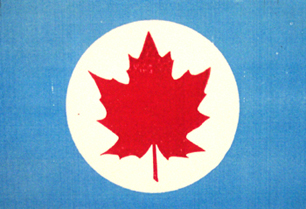



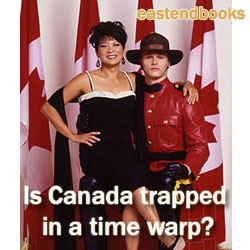
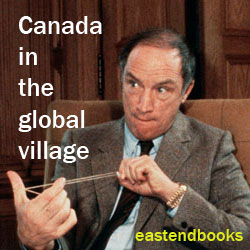
[…] Standing up for Canadian flag’s 50th birthday […]
About one thing I disagree.If Canada had declared-or been granted- its independence in the late 19th century,I doubt the Americans would have moved in and tried to take us over.Strangely enough some monarchists/imperialists still use that argument today to justify retention of the monarchy-even though it makes no sense now(If it ever did)